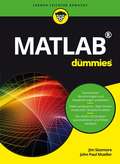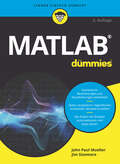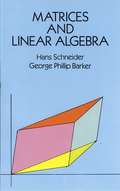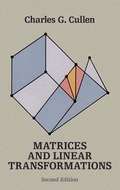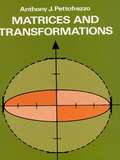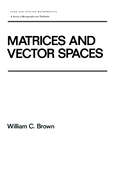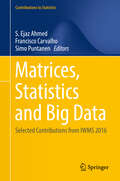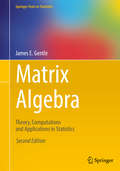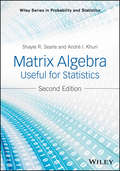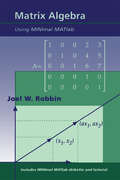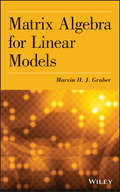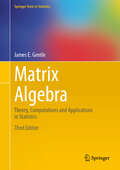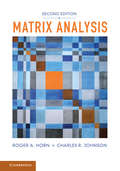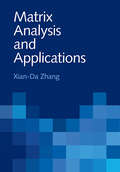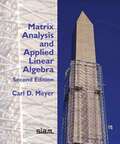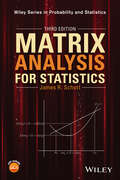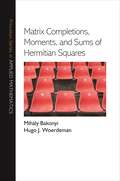- Table View
- List View
Matlab für Dummies (Für Dummies)
by Jim SizemoreOb Naturwissenschaftler, Mathematiker, Ingenieur oder Datenwissenschaftler - mit MATLAB haben Sie ein mächtiges Tool in der Hand, das Ihnen die Arbeit mit Ihren Daten erleichtert. Aber wie das mit manch mächtigen Dingen so ist - es ist auch ganz schön kompliziert. Aber keine Sorge! Jim Sizemore führt Sie in diesem Buch Schritt für Schritt an das Programm heran - von der Installation und den ersten Skripten bis hin zu aufwändigen Berechnungen, der Erstellung von Grafiken und effizienter Fehlerbehebung. Sie werden begeistert sein, was Sie mit MATLAB alles anstellen können.
Matlab für Dummies (Für Dummies)
by John Paul Mueller Jim SizemoreMATLAB® So lernen Sie MATLAB ideal zu nutzen Ob Naturwissenschaftler, Mathematiker, Ingenieur oder Datenwissenschaftler - mit MATLAB haben Sie ein mächtiges Tool in der Hand, das Ihnen die Arbeit mit Ihren Daten erleichtert. Aber wie das mit manch mächtigen Dingen so ist - es ist auch ganz schön kompliziert. Aber keine Sorge! Die Autoren führen Sie in diesem Buch Schritt für Schritt an das Programm heran - von der Installation und den ersten Skripten bis hin zu aufwändigen Berechnungen, der Erstellung von Grafiken und effizienter Fehlerbehebung. Sie werden begeistert sein, was Sie mit MATLAB alles anstellen können. Sie erfahren Was es mit dem MATLAB-Dateisystem auf sich hat Wie Sie mathematische Operationen mit Vektoren und Matrizen durchführen Wie Sie Funktionen und Skripte erstellen Wie Sie importieren, exportieren und publizieren.
Matrices and Linear Algebra (Dover Books on Mathematics)
by Hans Schneider George Phillip BarkerLinear algebra is one of the central disciplines in mathematics. A student of pure mathematics must know linear algebra if he is to continue with modern algebra or functional analysis. Much of the mathematics now taught to engineers and physicists requires it.This well-known and highly regarded text makes the subject accessible to undergraduates with little mathematical experience. Written mainly for students in physics, engineering, economics, and other fields outside mathematics, the book gives the theory of matrices and applications to systems of linear equations, as well as many related topics such as determinants, eigenvalues, and differential equations.Table of Contents:l. The Algebra of Matrices2. Linear Equations3. Vector Spaces4. Determinants5. Linear Transformations6. Eigenvalues and Eigenvectors7. Inner Product Spaces8. Applications to Differential EquationsFor the second edition, the authors added several exercises in each chapter and a brand new section in Chapter 7. The exercises, which are both true-false and multiple-choice, will enable the student to test his grasp of the definitions and theorems in the chapter. The new section in Chapter 7 illustrates the geometric content of Sylvester's Theorem by means of conic sections and quadric surfaces. 6 line drawings. lndex. Two prefaces. Answer section.
Matrices and Linear Transformations: Second Edition
by Charles G. Cullen"Comprehensive . . . an excellent introduction to the subject." -- Electronic Engineer's Design Magazine.This introductory textbook, aimed at sophomore- and junior-level undergraduates in mathematics, engineering, and the physical sciences, offers a smooth, in-depth treatment of linear algebra and matrix theory. The major objects of study are matrices over an arbitrary field. Contents include Matrices and Linear Systems; Vector Spaces; Determinants; Linear Transformations; Similarity: Part I and Part II; Polynomials and Polynomial Matrices; Matrix Analysis; and Numerical Methods. The first seven chapters, which require only a first course in calculus and analytic geometry, deal with matrices and linear systems, vector spaces, determinants, linear transformations, similarity, polynomials, and polynomial matrices. Chapters 8 and 9, parts of which require the student to have completed the normal course sequence in calculus and differential equations, provide introductions to matrix analysis and numerical linear algebra, respectively. Among the key features are coverage of spectral decomposition, the Jordan canonical form, the solution of the matrix equation AX = XB, and over 375 problems, many with answers.
Matrices and Transformations (Dover Books on Mathematics)
by Anthony J. PettofrezzoThis book presents an elementary and concrete approach to linear algebra that is both useful and essential for the beginning student and teacher of mathematics. Here are the fundamental concepts of matrix algebra, first in an intuitive framework and then in a more formal manner. A Variety of interpretations and applications of the elements and operations considered are included. In particular, the use of matrices in the study of transformations of the plane is stressed. The purpose of this book is to familiarize the reader with the role of matrices in abstract algebraic systems, and to illustrate its effective use as a mathematical tool in geometry. The first two chapters cover the basic concepts of matrix algebra that are important in the study of physics, statistics, economics, engineering, and mathematics. Matrices are considered as elements of an algebra. The concept of a linear transformation of the plane and the use of matrices in discussing such transformations are illustrated in Chapter #. Some aspects of the algebra of transformations and its relation to the algebra of matrices are included here. The last chapter on eigenvalues and eigenvectors contains material usually not found in an introductory treatment of matrix algebra, including an application of the properties of eigenvalues and eigenvectors to the study of the conics. Considerable attention has been paid throughout to the formulation of precise definitions and statements of theorems. The proofs of most of the theorems are included in detail in this book. Matrices and Transformations assumes only that the reader has some understanding of the basic fundamentals of vector algebra. Pettofrezzo gives numerous illustrative examples, practical applications, and intuitive analogies. There are many instructive exercises with answers to the odd-numbered questions at the back. The exercises range from routine computations to proofs of theorems that extend the theory of the subject. Originally written for a series concerned with the mathematical training of teachers, and tested with hundreds of college students, this book can be used as a class or supplementary text for enrichments programs at the high school level, a one-semester college course, individual study, or for in-service programs.
Matrices and Vector SPates (Chapman & Hall/CRC Pure and Applied Mathematics)
by William BrownA textbook for a one-semester course in linear algebra for graduate or upper-level undergraduate students of mathematics and engineering. Employs a matrix perspective, and emphasizes training in definitions, theorems, and proofs. Annotation copyright Book News, Inc. Portland, Or.
Matrices, Statistics and Big Data: Selected Contributions from IWMS 2016 (Contributions to Statistics)
by S. Ejaz Ahmed Simo Puntanen Francisco CarvalhoThis volume features selected, refereed papers on various aspects of statistics, matrix theory and its applications to statistics, as well as related numerical linear algebra topics and numerical solution methods, which are relevant for problems arising in statistics and in big data. The contributions were originally presented at the 25th International Workshop on Matrices and Statistics (IWMS 2016), held in Funchal (Madeira), Portugal on June 6-9, 2016. The IWMS workshop series brings together statisticians, computer scientists, data scientists and mathematicians, helping them better understand each other’s tools, and fostering new collaborations at the interface of matrix theory and statistics.
Matrix Algebra
by James E. GentleMatrix algebra is one of the most important areas of mathematics for data analysis and for statistical theory. This much-needed work presents the relevant aspects of the theory of matrix algebra for applications in statistics. It moves on to consider the various types of matrices encountered in statistics, such as projection matrices and positive definite matrices, and describes the special properties of those matrices. Finally, it covers numerical linear algebra, beginning with a discussion of the basics of numerical computations, and following up with accurate and efficient algorithms for factoring matrices, solving linear systems of equations, and extracting eigenvalues and eigenvectors.
Matrix Algebra
by Karim M. Abadir Jan R. MagnusThe first volume of the Econometric Exercises Series, Matrix Algebra contains exercises relating to course material in matrix algebra that students are expected to know while enrolled in an (advanced) undegraduate or a postgraduate course in econometrics or statistics. The book features a comprehensive collection of exercises with complete answers. More than just a collection of exercises, the volume is a textbook organized in a completely different manner than the usual textbook. It can be used as a self-contained course in matrix algebra or as a supplementary text.
Matrix Algebra Useful for Statistics
by Shayle R. Searle Andre I. KhuriA thoroughly updated guide to matrix algebra and it uses in statistical analysis and features SAS®, MATLAB®, and R throughout This Second Edition addresses matrix algebra that is useful in the statistical analysis of data as well as within statistics as a whole. The material is presented in an explanatory style rather than a formal theorem-proof format and is self-contained. Featuring numerous applied illustrations, numerical examples, and exercises, the book has been updated to include the use of SAS, MATLAB, and R for the execution of matrix computations. In addition, André I. Khuri, who has extensive research and teaching experience in the field, joins this new edition as co-author. The Second Edition also: Contains new coverage on vector spaces and linear transformations and discusses computational aspects of matrices Covers the analysis of balanced linear models using direct products of matrices Analyzes multiresponse linear models where several responses can be of interest Includes extensive use of SAS, MATLAB, and R throughout Contains over 400 examples and exercises to reinforce understanding along with select solutions Includes plentiful new illustrations depicting the importance of geometry as well as historical interludes Matrix Algebra Useful for Statistics, Second Edition is an ideal textbook for advanced undergraduate and first-year graduate level courses in statistics and other related disciplines. The book is also appropriate as a reference for independent readers who use statistics and wish to improve their knowledge of matrix algebra. THE LATE SHAYLE R. SEARLE, PHD, was professor emeritus of biometry at Cornell University. He was the author of Linear Models for Unbalanced Data and Linear Models and co-author of Generalized, Linear, and Mixed Models, Second Edition, Matrix Algebra for Applied Economics, and Variance Components, all published by Wiley. Dr. Searle received the Alexander von Humboldt Senior Scientist Award, and he was an honorary fellow of the Royal Society of New Zealand. ANDRÉ I. KHURI, PHD, is Professor Emeritus of Statistics at the University of Florida. He is the author of Advanced Calculus with Applications in Statistics, Second Edition and co-author of Statistical Tests for Mixed Linear Models, all published by Wiley. Dr. Khuri is a member of numerous academic associations, among them the American Statistical Association and the Institute of Mathematical Statistics.
Matrix Algebra Using MINimal MATlab
by Joel W. RobbinThe strength of this textbook lies in the careful exposition of mathematical thinking, basic set-theoretic notions, and proof techniques combined with contemporary numerical methods used throughout the book. A basic version of computer programs compatible with the widely used program MatLab, and exercises are provided on a disk included with the book.Warmup * Matrix Operations * Invertible Matrices * Subspaces * Rank and Dimension * Geometry * Determinants-I * Diagonalization * Differential Equations * Hermitian Matrices * Triangular Matrices * Unitary Matrices * Block Diagonalization * Jordan Normal Form * Determinants-II * Proofs * Mathematical Induction†* Summary of MINIMAT * Answers * MINIMAT Tutorial (PC Version)
Matrix Algebra for Linear Models
by Marvin H. GruberA self-contained introduction to matrix analysis theory and applications in the field of statisticsComprehensive in scope, Matrix Algebra for Linear Models offers a succinct summary of matrix theory and its related applications to statistics, especially linear models. The book provides a unified presentation of the mathematical properties and statistical applications of matrices in order to define and manipulate data.Written for theoretical and applied statisticians, the book utilizes multiple numerical examples to illustrate key ideas, methods, and techniques crucial to understanding matrix algebra's application in linear models. Matrix Algebra for Linear Models expertly balances concepts and methods allowing for a side-by-side presentation of matrix theory and its linear model applications. Including concise summaries on each topic, the book also features:Methods of deriving results from the properties of eigenvalues and the singular value decompositionSolutions to matrix optimization problems for obtaining more efficient biased estimators for parameters in linear regression modelsA section on the generalized singular value decompositionMultiple chapter exercises with selected answers to enhance understanding of the presented materialMatrix Algebra for Linear Models is an ideal textbook for advanced undergraduate and graduate-level courses on statistics, matrices, and linear algebra. The book is also an excellent reference for statisticians, engineers, economists, and readers interested in the linear statistical model.
Matrix Algebra: Theory, Computations and Applications in Statistics (Springer Texts in Statistics)
by James E. GentleThis book presents the theory of matrix algebra for statistical applications, explores various types of matrices encountered in statistics, and covers numerical linear algebra. Matrix algebra is one of the most important areas of mathematics in data science and in statistical theory, and previous editions had essential updates and comprehensive coverage on critical topics in mathematics.This 3rd edition offers a self-contained description of relevant aspects of matrix algebra for applications in statistics. It begins with fundamental concepts of vectors and vector spaces; covers basic algebraic properties of matrices and analytic properties of vectors and matrices in multivariate calculus; and concludes with a discussion on operations on matrices, in solutions of linear systems and in eigenanalysis. It also includes discussions of the R software package, with numerous examples and exercises.Matrix Algebra considers various types of matrices encountered in statistics, such as projection matrices and positive definite matrices, and describes special properties of those matrices; as well as describing various applications of matrix theory in statistics, including linear models, multivariate analysis, and stochastic processes. It begins with a discussion of the basics of numerical computations and goes on to describe accurate and efficient algorithms for factoring matrices, how to solve linear systems of equations, and the extraction of eigenvalues and eigenvectors. It covers numerical linear algebra—one of the most important subjects in the field of statistical computing. The content includes greater emphases on R, and extensive coverage of statistical linear models. Matrix Algebra is ideal for graduate and advanced undergraduate students, or as a supplementary text for courses in linear models or multivariate statistics. It’s also ideal for use in a course in statistical computing, or as a supplementary text forvarious courses that emphasize computations.
Matrix Analysis (2nd Edition)
by Charles R. Johnson Roger A. HornIn this book the authors present classical and recent results for matrix analysis that have proved to be important to applied mathematics. Facts about matrices, beyond those found in an elementary linear algebra course, are needed to understand virtually any area of mathematics, and the necessary material has only occurred sporadically in the literature and university curricula. As the interest in applied mathematics has grown, the need for a text and a reference work offering a broad selection of topics has become apparent, and this book aims to meet that need. This book will be welcomed as an undergraduate or graduate textbook for students studying matrix analysis. The authors assume a background in elementary linear algebra and knowledge of rudimentary analytical concepts. They begin with a review and discussion of eigenvalues and eigenvectors. The following chapters each treat a major topic in depth. This volume should be useful not only as a text, but also as a self-contained reference work to a variety of audiences in other scientific fields.
Matrix Analysis And Applications
by Xian-Da ZhangThis balanced and comprehensive study presents the theory, methods, and applications of matrix analysis in a new theoretical framework, allowing readers to understand second-order and higher-order matrix analysis in a completely new light. Alongside the core subjects in matrix analysis, such as singular value analysis, solving matrix equations and eigenanalysis, the author introduces new applications and perspectives that are unique to this book. As a very topical subject matter, gradient analysis and optimization plays a central role here. Also included are subspace analysis, projection analysis, and tensor analysis, topics which are often neglected in other books. Having provided a solid foundation to the subject, the author goes on to place particular emphasis on the many applications matrix analysis can have in science and engineering, making this book suitable for scientists, engineers, and graduate students alike.
Matrix Analysis and Applied Linear Algebra
by Carl D. MeyerThis second edition has been almost completely rewritten to create a textbook designed so instructors can determine the degree of rigor and flexible enough for a one- or two-semester course. The author achieves this by increasing the level of sophistication as the text proceeds from traditional first principles in the early chapters to theory and applications in the later ones, and by ensuring that material at any point is not dependent on subsequent developments. While theorems and proofs are highlighted, the emphasis is on applications. The author provides carefully constructed exercises ranging from easy to moderately challenging to difficult, many of which condition students for topics that follow. An accompanying book, Matrix Analysis and Applied Linear Algebra, Second Edition, Study and Solutions Guide, contains complete solutions and discussions of each exercise; and historical remarks that focus on the personalities of the individuals who created and contributed to the subject's development. This book is designed for use in either a one- or two-term linear algebra course. It can also serve as a reference to anyone who needs to use or apply linear algebra.
Matrix Analysis for Statistics
by James R. SchottAn up-to-date version of the complete, self-contained introduction to matrix analysis theory and practice Providing accessible and in-depth coverage of the most common matrix methods now used in statistical applications, Matrix Analysis for Statistics, Third Edition features an easy-to-follow theorem/proof format. Featuring smooth transitions between topical coverage, the author carefully justifies the step-by-step process of the most common matrix methods now used in statistical applications, including eigenvalues and eigenvectors; the Moore-Penrose inverse; matrix differentiation; and the distribution of quadratic forms. An ideal introduction to matrix analysis theory and practice, Matrix Analysis for Statistics, Third Edition features: * New chapter or section coverage on inequalities, oblique projections, and antieigenvalues and antieigenvectors * Additional problems and chapter-end practice exercises at the end of each chapter * Extensive examples that are familiar and easy to understand * Self-contained chapters for flexibility in topic choice * Applications of matrix methods in least squares regression and the analyses of mean vectors and covariance matrices Matrix Analysis for Statistics, Third Edition is an ideal textbook for upper-undergraduate and graduate-level courses on matrix methods, multivariate analysis, and linear models. The book is also an excellent reference for research professionals in applied statistics. James R. Schott, PhD, is Professor in the Department of Statistics at the University of Central Florida. He has published numerous journal articles in the area of multivariate analysis. Dr. Schott's research interests include multivariate analysis, analysis of covariance and correlation matrices, and dimensionality reduction techniques.
Matrix Completions, Moments, and Sums of Hermitian Squares (Princeton Series in Applied Mathematics #37)
by Hugo J. Woerdeman Mihály BakonyiIntensive research in matrix completions, moments, and sums of Hermitian squares has yielded a multitude of results in recent decades. This book provides a comprehensive account of this quickly developing area of mathematics and applications and gives complete proofs of many recently solved problems. With MATLAB codes and more than 200 exercises, the book is ideal for a special topics course for graduate or advanced undergraduate students in mathematics or engineering, and will also be a valuable resource for researchers. Often driven by questions from signal processing, control theory, and quantum information, the subject of this book has inspired mathematicians from many subdisciplines, including linear algebra, operator theory, measure theory, and complex function theory. In turn, the applications are being pursued by researchers in areas such as electrical engineering, computer science, and physics. The book is self-contained, has many examples, and for the most part requires only a basic background in undergraduate mathematics, primarily linear algebra and some complex analysis. The book also includes an extensive discussion of the literature, with close to 600 references from books and journals from a wide variety of disciplines.
Matrix Computations and Semiseparable Matrices: Eigenvalue and Singular Value Methods
by Marc Van Barel Raf Vandebril Nicola MastronardiThe general properties and mathematical structures of semiseparable matrices were presented in volume 1 of Matrix Computations and Semiseparable Matrices. In volume 2, Raf Vandebril, Marc Van Barel, and Nicola Mastronardi discuss the theory of structured eigenvalue and singular value computations for semiseparable matrices. These matrices have hidden properties that allow the development of efficient methods and algorithms to accurately compute the matrix eigenvalues. This thorough analysis of semiseparable matrices explains their theoretical underpinnings and contains a wealth of information on implementing them in practice. Many of the routines featured are coded in Matlab and can be downloaded from the Web for further exploration.
Matrix Computations and Semiseparable Matrices: Linear Systems
by Raf Vandebril Marc van Van Barel Nicola MastronardiIn recent years several new classes of matrices have been discovered and their structure exploited to design fast and accurate algorithms. In this new reference work, Raf Vandebril, Marc Van Barel, and Nicola Mastronardi present the first comprehensive overview of the mathematical and numerical properties of the family's newest member: semiseparable matrices. The text is divided into three parts. The first provides some historical background and introduces concepts and definitions concerning structured rank matrices. The second offers some traditional methods for solving systems of equations involving the basic subclasses of these matrices. The third section discusses structured rank matrices in a broader context, presents algorithms for solving higher-order structured rank matrices, and examines hybrid variants such as block quasiseparable matrices. An accessible case study clearly demonstrates the general topic of each new concept discussed. Many of the routines featured are implemented in Matlab and can be downloaded from the Web for further exploration.
Matrix Differential Calculus with Applications in Statistics and Econometrics (Wiley Series in Probability and Statistics #Vol. 395)
by Jan R. Magnus Heinz NeudeckerA brand new, fully updated edition of a popular classic on matrix differential calculus with applications in statistics and econometrics This exhaustive, self-contained book on matrix theory and matrix differential calculus provides a treatment of matrix calculus based on differentials and shows how easy it is to use this theory once you have mastered the technique. Jan Magnus, who, along with the late Heinz Neudecker, pioneered the theory, develops it further in this new edition and provides many examples along the way to support it. Matrix calculus has become an essential tool for quantitative methods in a large number of applications, ranging from social and behavioral sciences to econometrics. It is still relevant and used today in a wide range of subjects such as the biosciences and psychology. Matrix Differential Calculus with Applications in Statistics and Econometrics, Third Edition contains all of the essentials of multivariable calculus with an emphasis on the use of differentials. It starts by presenting a concise, yet thorough overview of matrix algebra, then goes on to develop the theory of differentials. The rest of the text combines the theory and application of matrix differential calculus, providing the practitioner and researcher with both a quick review and a detailed reference. Fulfills the need for an updated and unified treatment of matrix differential calculus Contains many new examples and exercises based on questions asked of the author over the years Covers new developments in field and features new applications Written by a leading expert and pioneer of the theory Part of the Wiley Series in Probability and Statistics Matrix Differential Calculus With Applications in Statistics and Econometrics Third Edition is an ideal text for graduate students and academics studying the subject, as well as for postgraduates and specialists working in biosciences and psychology.
Matrix Inequalities for Iterative Systems
by Hanjo TaubigThe book reviews inequalities for weighted entry sums of matrix powers. Applications range from mathematics and CS to pure sciences. It unifies and generalizes several results for products and powers of sesquilinear forms derived from powers of Hermitian, positive-semidefinite, as well as nonnegative matrices. It shows that some inequalities are valid only in specific cases. How to translate the Hermitian matrix results into results for alternating powers of general rectangular matrices? Inequalities that compare the powers of the row and column sums to the row and column sums of the matrix powers are refined for nonnegative matrices. Lastly, eigenvalue bounds and derive results for iterated kernels are improved.
Matrix Information Geometry
by Rajendra Bhatia Frank NielsenThis book presents advances in matrix and tensor data processing in the domain of signal, image and information processing. The theoretical mathematical approaches are discusses in the context of potential applications in sensor and cognitive systems engineering. The topics and application include Information Geometry, Differential Geometry of structured Matrix, Positive Definite Matrix, Covariance Matrix, Sensors (Electromagnetic Fields, Acoustic sensors) and Applications in Cognitive systems, in particular Data Mining.
Matrix Mathematics: Theory, Facts, and Formulas - Second Edition
by Dennis S. BernsteinWhen first published in 2005, Matrix Mathematics quickly became the essential reference book for users of matrices in all branches of engineering, science, and applied mathematics. In this fully updated and expanded edition, the author brings together the latest results on matrix theory to make this the most complete, current, and easy-to-use book on matrices. Each chapter describes relevant background theory followed by specialized results. Hundreds of identities, inequalities, and matrix facts are stated clearly and rigorously with cross references, citations to the literature, and illuminating remarks. Beginning with preliminaries on sets, functions, and relations,Matrix Mathematics covers all of the major topics in matrix theory, including matrix transformations; polynomial matrices; matrix decompositions; generalized inverses; Kronecker and Schur algebra; positive-semidefinite matrices; vector and matrix norms; the matrix exponential and stability theory; and linear systems and control theory. Also included are a detailed list of symbols, a summary of notation and conventions, an extensive bibliography and author index with page references, and an exhaustive subject index. This significantly expanded edition of Matrix Mathematics features a wealth of new material on graphs, scalar identities and inequalities, alternative partial orderings, matrix pencils, finite groups, zeros of multivariable transfer functions, roots of polynomials, convex functions, and matrix norms. Covers hundreds of important and useful results on matrix theory, many never before available in any book Provides a list of symbols and a summary of conventions for easy use Includes an extensive collection of scalar identities and inequalities Features a detailed bibliography and author index with page references Includes an exhaustive subject index with cross-referencing
Matrix Operations for Engineers and Scientists
by Alan JeffreyEngineers and scientists need to have an introduction to the basics of linear algebra in a context they understand. Computer algebra systems make the manipulation of matrices and the determination of their properties a simple matter, and in practical applications such software is often essential. However, using this tool when learning about matrices, without first gaining a proper understanding of the underlying theory, limits the ability to use matrices and to apply them to new problems. This book explains matrices in the detail required by engineering or science students, and it discusses linear systems of ordinary differential equations. These students require a straightforward introduction to linear algebra illustrated by applications to which they can relate. It caters of the needs of undergraduate engineers in all disciplines, and provides considerable detail where it is likely to be helpful. According to the author the best way to understand the theory of matrices is by working simple exercises designed to emphasize the theory, that at the same time avoid distractions caused by unnecessary numerical calculations. Hence, examples and exercises in this book have been constructed in such a way that wherever calculations are necessary they are straightforward. For example, when a characteristic equation occurs, its roots (the eigenvalues of a matrix) can be found by inspection. The author of this book is Alan Jeffrey, Emeritus Professor of mathematics at the University of Newcastle upon Tyne. He has given courses on engineering mathematics at UK and US Universities.
